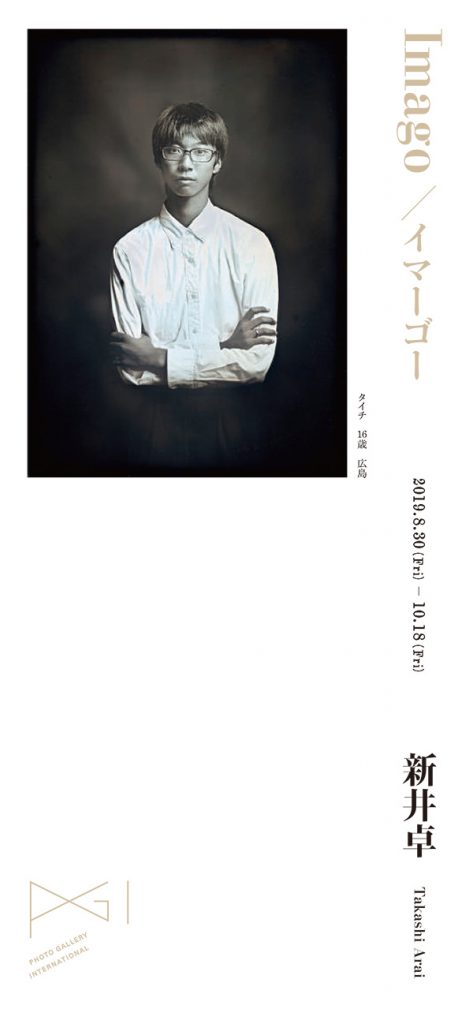IMAGO: Takashi Arai
Aug 30 (Reception 18:00) – Oct 18, 2019
PGI, Tokyo
*Sept 20 (Fri): “Oshira Kagami” Film Screening
*Sept 21 (Sat): “Oshira Kagami” Film Screening + Artist’s Talk with Models
https://www.pgi.ac
新井卓「イマーゴー」展
2019/8/30 (オープニング午後6時) – 10/18
PGI, 東京
*9/20(金)夜『オシラ鏡』上映会
*9/21(土)午後『オシラ鏡』上映会 + トーク(撮影当時のティーンエイジャーたちと)
https://www.pgi.ac
Takashi Arai is one of the few artists working with the daguerreotype today, the world’s first widely available photographic process. This exhibition, entitled Imago, features work from the Tomorrow’s History, an ongoing project which began in 2016. This is his second exhibition at PGI.
By their very nature photographs depict the past, and mine are no exception. With this in mind I asked myself a simple question: “Can we predict the future?” To seek out the answer I began working on Tomorrow’s History, a series of portraits and interviews with teens between the ages of fourteen and seventeen.
Daguerreotypes typically require an exposure time of several seconds. To get around this I’ve employed powerful flashes capable of emitting tens of thousands of watts of light.
I derived inspiration from the portraits from an unforgettable Kurt Gunther painting of a little boy I once saw at a museum in LA. The unusual painting, made in 1928, features a boy I imagine to be the poster child for German youth of that era with his immaculately parted hair and shorts sitting cross-legged and glaring at the viewer. He gives off an unsettling aura, as though he knows what’s to come in the years that follow. More than anything, though, I recall his huge, narrowed eyes beaming back at me.
Until now my daguerreotypes have been somewhat blurred due to the long exposure times, which can range from a few seconds to tens of minutes. To me that look was more of a nice feature than a drawback. This time, however, I felt it was of the utmost importance to recreate the sharp eyes of the boy in Gunther’s painting.”
–Excerpt from the January 2017 17th Special Edition of SUBARU ‘For Tomorrow’s History – Daguerreotype Portraits of Seventeen-year-olds’
While Arai’s previous works have dealt with uncertainty, this series aimed to bring everything into exquisite focus. By seeking out, photographing and interviewing these young people I’ve put together a glimpse into possible futures as imagined by them.
Tomorrow’s History (2016-)
Tomorrow’s History began with a simple question: “Can we predict the future?” It is a series of daguerreotype portraits of teenagers with their interviews. After the 2011 Tōhoku earthquake and tsunami, I was shaken by the helplessly parochial standpoint of this country, which made me want to meet and directly hear what fourteen to seventeen year olds, for instance, were feeling and thinking at the present moment. Simply through an age bracket, we might be able to catch a glimpse of unseen facets of Japan, or aspects of the future yet to come.
Prompted by the strangely, utterly clear eyes of the boy in the painting made right before the outbreak of the World War II by the German Neue Sachlichkeit (New Objectivity) painter, Kurt Gunther, I experimented using electronic flashes with several tens of thousands of watts as an attempt to capture the slice of moment.
Daguerreotype, which is proven of at least 180 years of lifespan, thus becomes the most trustful memory device, which contains and passes down their likness to future generations after hundreds years.
Takashi Arai
Takashi Arai does not see daguerreotype as a nostalgic reproduction of a classical method; instead, he has made it his own personal medium, finding it a reliable device for storing memory that is far better for recording and transmitting interactions with his subjects than modern photography.
Beginning in 2010, when he first became interested in nuclear issues, Arai has used the daguerreotype technique to create individual records―micro-monuments―of his encounters with surviving crew members, and the salvaged hull, of the fallout-contaminated Daigo Fukuryūmaru fishing boat, records that touch upon the fragmented reality of events in the past. This project led him to photograph the deeply interconnected subjects of Fukushima, Hiroshima, and Nagasaki.
Arai’s work has appeared in numerous exhibitions, at the Museum of Fine Arts, Boston, Mori Art Museum, the National Museum of Modern Art, Tokyo, among other international venues.
In 2016, he received the 41st Kimura Ihei Award for his first monograph “MONUMENTS”(PGI, 2015). In 2018, Arai’s first short film “Oshira Kagami: The Mirror of the Oshira Deity” won the Category Prize at the 72nd Salerno International Film Festival, Italy.
His works are held in the public collections of the San Francisco Museum of Modern Art, the Hirshhorn Museum and Sculpture Garden, the Museum of Fine Arts, Boston, the National Museum of Modern Art, Tokyo, and Musée Guimet, among others.
Arai is a visiting researcher at National Museum of Ethnology since 2017.
新井は写真黎明期の技法であるダゲレオタイプを使って表現する数少ない写真家の一人です。
本展では「Imago/イマーゴー」と題し2016年より取り組んでいるプロジェクト、「明日の歴史」を展示いたします。PGIでは2回目の個展となります。
写真が常に過去であること、自身の作品も例外ではなく、「確実に過去になっていく」。そのことに端を発した「わたしたちは未来を予測することができるか」というシンプルな疑問から、14歳から17歳の若者のポートレイトと聴き取りによる「明日の歴史」のプロジェクトをスタートさせました。
ダゲレオタイプは感度が低いために、通常の撮影では数秒以上の長時間露光が必要となりますが、このプロジェクトではそれを避けるために数万ワットセカンドの大光量ストロボを使用しています。
「肖像写真は、いつかロスアンジェルスの美術館で見かけて以来ずっと気になっていた、クルト・ギュンターの少年の絵が、手がかりになりそうだった。一九二八年に描かれたその絵は、綺麗になでつけた髪と半ズボン姿の、おそらくは当時の典型的ドイツ少年が、足と腕を組みじっとこちらを見つめている、不思議に印象的な肖像画である。来るべき時代の先触れ、とでもいうような不穏な空気が画面から漂いだしていたが、なによりも、ほっそりした顔の中心を支配する、異様に大きな、輝く二つの眼が強烈に記憶に残った。
今までわたしが取り組んできた、ダゲレオタイプによるポートレイトは、数秒から時に十数分にわたる長時間露光のため輪郭がすこしぼやけるのが常だったし、むしろそれを好んで作品に採り入れてきた。しかし、今度はそうではなく、こちらを一直線に見つめかえす揺るぎない眼差し──ギュンターの少年の眼差しが、どうしても必要だと直感した。」
(『すばる』2017年1月号特集「17」明日の歴史のために──ダゲレオタイプで写す、十七歳の肖像より)
これまでの作品では、常に内なる不確かさと向き合ってきましたが、本作では、むしろ研ぎ澄まされた精緻な像に挑戦しています。
被写体として撮影に参加してくれる若者を探し、インタビューを行い、撮影をする、という繰り返しの中で生まれてきた肖像群は、作品の前で、耳を澄まし、見つめることを追体験する私たちに、あるひとつの未来の形を垣間見せてくれます。
明日の歴史(2016-)
新井卓
《明日の歴史》は、わたしたちは未来を予測することができるか、という単純な疑問から出発した、若者のダゲレオタイプ・ポートレイトと、聴き取りによるシリーズである。2011年の震災後、目にみえて閉塞してゆくこの国のありさまに震撼としながら、いま、たとえば14–17歳の彼/彼女らは何を感じ、何を思うのか、直接会って話を聞きたいと思った。年齢という単純な枠組み(フレーム)によって、これまで見えてこなかった日本の相貌、あるいは、やがてあらわれる未来の諸相が垣間見えるかもしれない──。
ドイツ新即物派の画家クルト・ギュンターが第二次大戦前夜に描いた、少年の絵の異様に澄み切った眼差しを手がかりに、はじめて数万ワットのストロボ閃光で瞬間をとらえる方法を試みた。
少なくとも百八十年の寿命が実証されているダゲレオタイプは、こうして、数百年後の未来へむけて彼女/彼たちの姿を運ぶ、最も信頼できる記憶装置となる。
新井 卓(あらい たかし)
1978年神奈川県川崎市生まれ。現在、川崎市、岩手県遠野市を拠点に活動する。
写真の原点を探るうち最初期の写真術・ダゲレオタイプ(銀板写真)を知り、試行錯誤ののち同技法を習得。対象に出会ったときの感覚を、時間と空間を超えて、見るものに生々しく伝えることのできる<小さなモニュメント>として、自身のメディアとしてきた。核の歴史に興味を持ち始めた2010年から、第五福竜丸の船体や元船員に出会い、その後、福島、長崎、広島、と撮るべき対象に自然に巡りあってきた。代表的なシリーズに、福島第一原発事故後の相双地域をドキュメントした「Here and There – 明日の島」、アトミック・エイジの記憶と記念物を巡る「百の太陽に灼かれて/EXPOSED IN A HUNDRED SUNS」のほか、なるべく毎日撮影をつづける「毎日のダゲレオタイプ・プロジェクト/Daily Daguerreotype Project」などがある。
近年は映画制作、執筆、講演のほか多岐にわたる活動を展開。これまで、ボストン美術館、サンフランシスコ近代美術館、森美術館、東京国立近代美術館ほか内外の多数の展覧会に参加した。2014年に英国ソースコード・プライズ(現 The Solas Prize)、2016年には第41回木村伊兵衛写真賞、日本写真協会賞新人賞、神奈川文化賞未来賞を続けて受賞。2018年、映像詩『オシラ鏡』で第72回サレルノ国際映画祭短編映画部門最高賞。スミソニアン博物館、ボストン美術館、サンフランシスコ近代美術館、東京国立近代美術館、東京都写真美術館、ギメ美術館ほか多数の美術館に作品収蔵。単著に『MONUMENTS』(PGI、2015)など。2017年から2019年まで、国立民族学博物館館外研究員(放射線影響をめぐる「当事者性」に関する学際的研究)。

Comments are closed, but trackbacks and pingbacks are open.